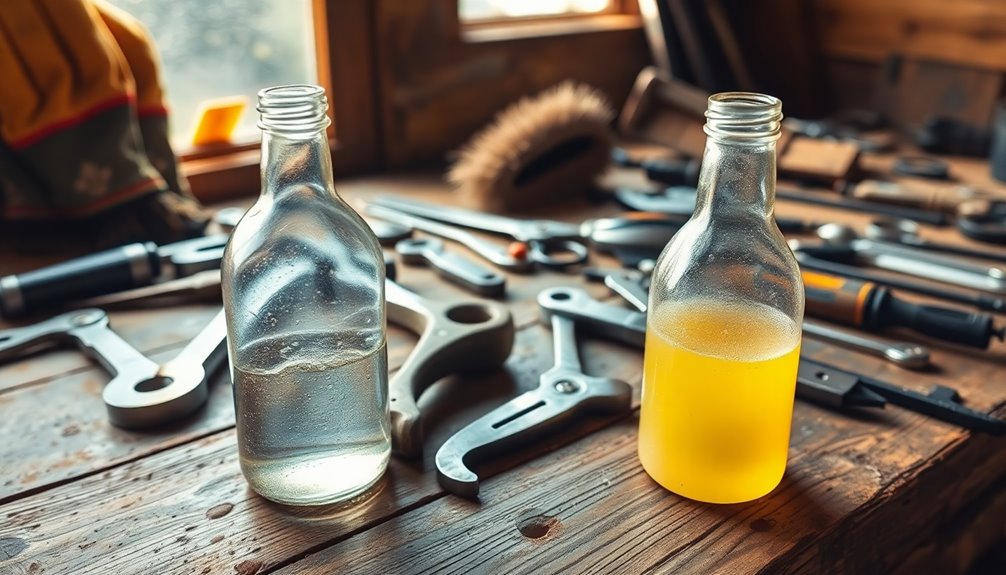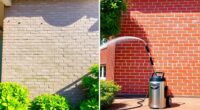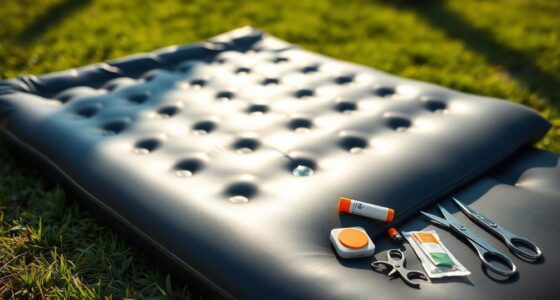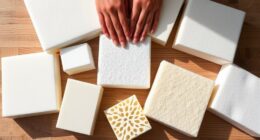To restore your rusted tools to like-new condition, start by soaking them in vinegar for 12 hours. If the rust's tough, create a mixture of vinegar and salt, submerging items for up to 12 hours. You can also use coarse sandpaper to sand away rust, moving to finer grits for a smooth finish. For tough spots, consider oxalic acid or try a lemon juice and salt mix. Don't forget to neutralize any acids with a baking soda rinse afterward. Want to discover some more effective and simple methods to keep your tools rust-free?
Key Takeaways
- Soak rusted tools in vinegar for at least 12 hours, then scrub with a damp pad for effective rust removal.
- Create a vinegar and salt solution, submerge items for 30 minutes to 12 hours, and scrub afterward for enhanced results.
- Use coarse grit sandpaper for initial rust removal, then progress to finer grits for smoothing and polishing.
- Apply oxalic acid solution for stubborn rust, letting it sit for 15-30 minutes before rinsing thoroughly.
- Consider lemon juice and baking soda as natural alternatives, scrubbing with an abrasive pad for effective rust removal.
Using Vinegar
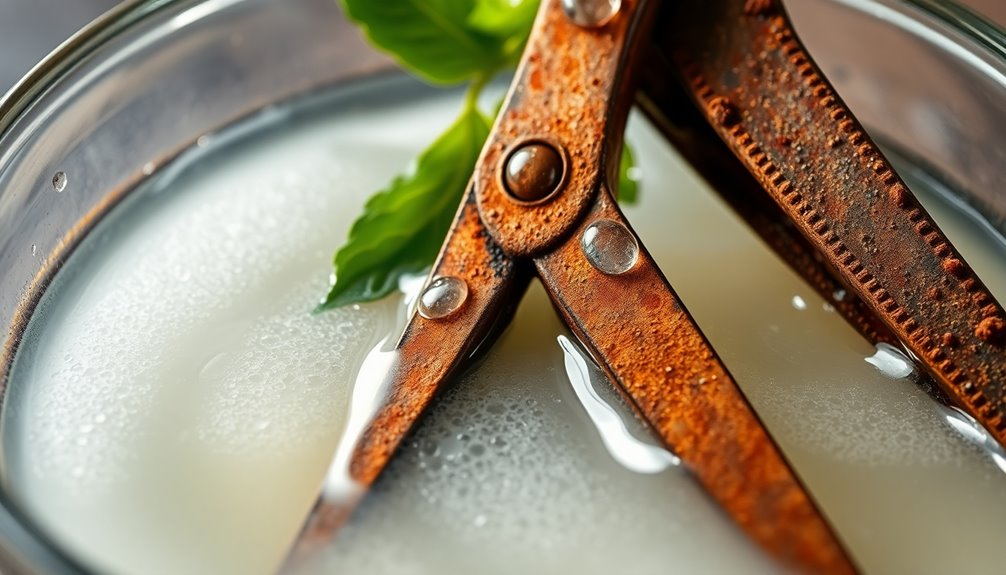
Using vinegar is one of the best methods for removing rust from your tools.
Start by cleaning the surface of the rusted item to eliminate any debris. Choose vinegar with 5-8% acetic acid for household tools, or go for a stronger 24% solution if needed. For larger rust problems, consider using a 5-gallon size vinegar option to effectively tackle multiple items.
Find a plastic or glass container deep enough to fully submerge the tool, then fill it with vinegar. Soak the tool for at least 12 hours, and if it can't be submerged, scrub it with a vinegar-dampened scouring pad.
For added effectiveness, you can wrap a vinegar-soaked cloth around rusted areas or spray the vinegar directly.
Just remember to neutralize the acidity afterward to protect your tool!
Vinegar and Salt Solution
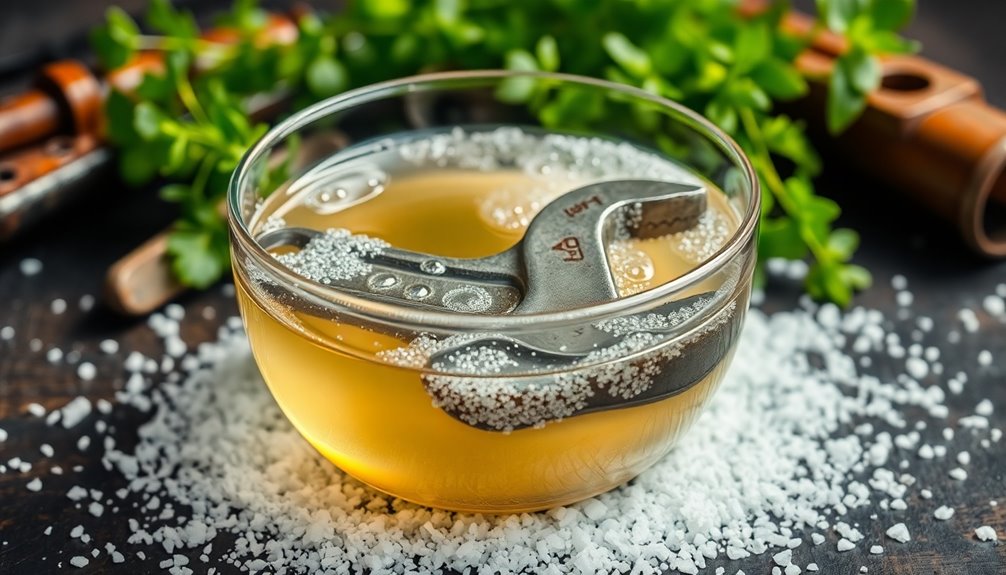
If you're looking for an even more effective method to tackle rust on your tools, consider combining vinegar with salt.
Start by preparing your vinegar solution: mix one gallon of distilled white vinegar with one cup of table salt in a bucket. Stir until the salt dissolves.
Next, fully submerge your rusted item in this solution for anywhere between 30 minutes and 12 hours, depending on how bad the rust is. Periodically check the item, especially if it's delicate. Make sure to ensure proper safety measures while handling vinegar.
After soaking, scrub the object with a brush while wearing latex gloves, then rinse it thoroughly.
To neutralize the acid, soak the item in a baking soda solution for about ten minutes before rinsing and drying completely.
Sanding Method
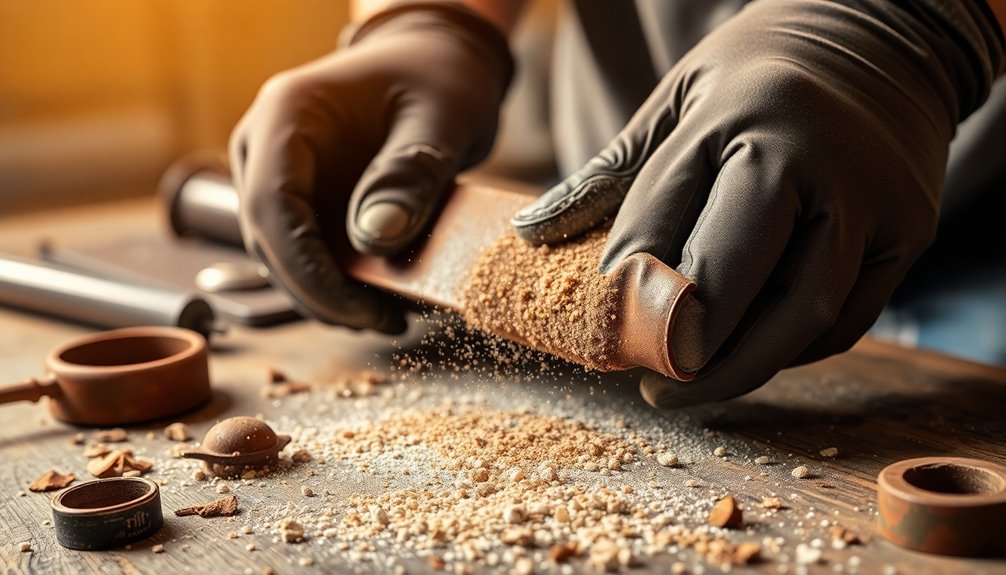
While there are various methods to remove rust from tools, the sanding method stands out for its effectiveness and accessibility.
Start by cleaning the tool to remove any loose debris. Choose coarse grit sandpaper (80-100) for initial rust removal and don protective gear like gloves and safety glasses.
Sand the rusty area in a circular motion, focusing on the rust while checking your progress regularly. If stubborn spots remain, use a wire brush before continuing.
Switch to finer grits (120-150) for smoothing, and finish with an even finer grit (220-240) for a polished look.
Finally, clean the tool thoroughly and apply a rust-inhibiting coating to prevent future rust.
Oxalic Acid
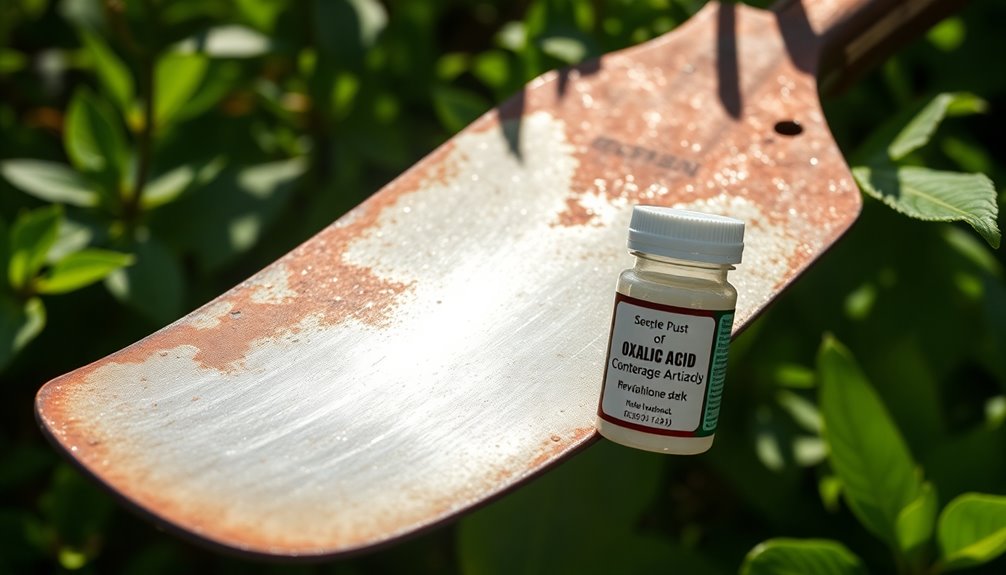
When it comes to effectively removing rust from tools, oxalic acid is a powerful option that can rejuvenate your metal surfaces.
To start, mix one part oxalic acid with two parts water to create your solution. Remember to wear protective gloves, goggles, and a mask, and ensure good ventilation.
Clean your tool thoroughly, then apply the solution to the rusty areas with a brush or cloth. Let it sit for 15-30 minutes before rinsing with water. If rust persists, reapply and wait another 15-30 minutes.
Afterward, dry the tool with a clean towel. For best results, consider polishing and lubricating your tool post-treatment to prevent future rust.
Store your tools in a dry area to maintain their condition.
Lemon Juice and Salt

Using lemon juice and salt can be a surprisingly effective method for removing rust from your tools.
Start by removing any parts that can be detached for better access. Mix equal parts of lemon juice and salt in a bowl, then use an abrasive pad to apply the mixture to the rusty areas, scrubbing in small circular motions. This mixture acts as an acid to loosen rust, allowing for easier removal.
Let it soak for 30 minutes to 2 hours, then scrub again to remove the loosened rust. Rinse your tool thoroughly in a sink and dry it completely with clean rags or paper towels.
If rust remains, repeat the soaking and scrubbing process. For heavily rusted tools, multiple applications may be necessary to achieve a rust-free finish.
Baking Soda
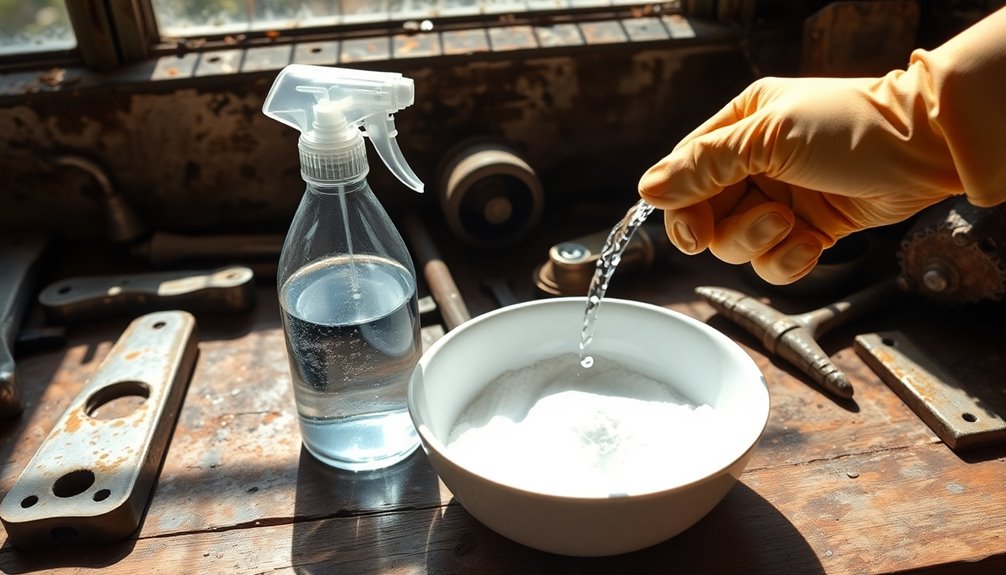
Baking soda is a powerful and versatile agent for tackling rust on your tools. To use it, start by wetting the rusty object and sprinkling a generous amount of baking soda on the area. This helps the baking soda stick to the rust.
Next, take a wet scrubbing pad and gently scrub the baking soda-covered surface, keeping the pad wet to avoid scratching. After about five minutes, check if the rust has lifted. If any rust remains, add more baking soda and continue scrubbing until it's gone. Cost-effective and environmentally friendly, baking soda isn't only effective for light to moderate rust, but it's also a great choice for rust removal.
Additional Tips
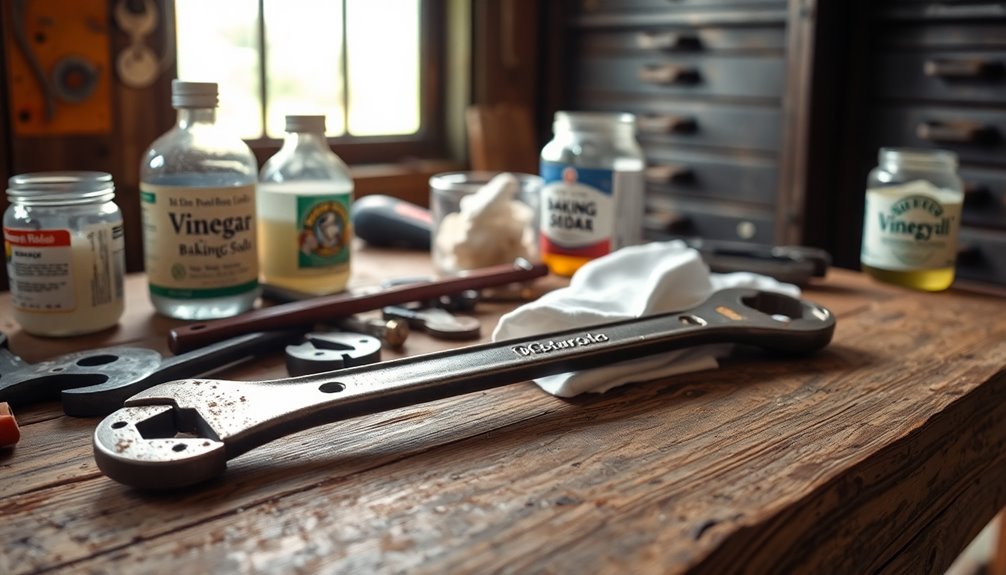
After you've tackled light to moderate rust with baking soda, you might want to explore some additional methods for removing rust from your tools.
One effective option is using a paste made from equal parts vinegar and salt. Apply it to the rusty area, let it sit for several hours, then rinse thoroughly.
Alternatively, spray WD-40 directly onto the rust, let it penetrate, and wipe off with a cloth.
For a more abrasive approach, rub coarse steel wool over the affected area, then rinse and dry.
Lastly, you can use CLR; just spray it on, rinse well, and dry the tool.
Always wear gloves for safety, especially when using harsher chemicals or abrasive materials.
Frequently Asked Questions
Can I Use These Methods on Chrome-Plated Tools?
Yes, you can use certain methods on chrome-plated tools, but you need to be cautious.
Avoid acidic solutions and abrasive materials that can scratch the surface. Instead, opt for alkaline cleaners and soft-bristled brushes to remove rust without damage.
If you choose electrochemical methods, ensure you control the current to protect the chrome.
Regular maintenance and proper storage can also help prevent rust buildup on your tools.
How Do I Know When Rust Is Completely Removed?
Did you know that over 30% of tools suffer from rust at some point?
To know when rust's completely removed, visually inspect for color change and smoothness. Use a touch test; the surface should feel solid and cool.
You can also perform chemical tests with vinegar or pH paper.
Finally, check the tool's functionality—sharpness and movement are key indicators that you've successfully eliminated rust.
Are These Methods Safe for Electrical Tools?
Yes, these methods can be safe for electrical tools if you follow specific precautions.
Avoid any contact with water, use non-conductive containers, and ensure secure connections during the process.
Maintain proper polarity and monitor the setup to prevent short circuits.
Wear rubber gloves when handling tools, and always rinse and dry them thoroughly afterward.
Just be cautious with any electrical components to avoid damage while you work on rust removal.
How Can I Prevent Rust From Returning?
Think of your tools as cherished friends; you wouldn't let them languish in dampness.
To prevent rust from returning, keep them dry and store them in a well-ventilated space. Use protective covers and consider rust-inhibiting sprays to shield them.
After each use, clean and dry them thoroughly, treating them with care.
Regularly inspect your tools, like a watchful guardian, ensuring they stay rust-free and ready for action whenever you need them.
What Should I Do if Rust Persists After Treatment?
If rust persists after treatment, start by assessing its severity.
Check for deep corrosion and evaluate the tool's material. If necessary, switch to more aggressive methods like commercial rust removers or mechanical removal techniques.
You might need to increase soaking time or combine different approaches. Ensure you're working in a well-ventilated area and wearing protective gear.
If the rust stays stubborn, consider seeking professional help for a thorough assessment and treatment.
Conclusion
Restoring your rusty tools doesn't have to be a daunting task; it can be a rewarding journey. Whether you choose the natural route with vinegar or the strength of oxalic acid, each method transforms decay into renewed potential. While rust may seem like an inevitable end, it's just a stepping stone to restoration. Embrace the process, and you'll not only reclaim your tools but also discover the satisfaction of breathing new life into what was once forgotten.
